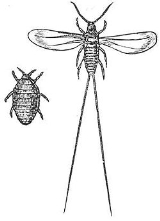
Cochineal
Overview
The cochineal is a scale insect
in the suborder Sternorrhyncha
, from which the crimson
-colour dye
carmine
is derived. A primarily sessile
parasite native to tropical and subtropical South America
and Mexico
, this insect lives on cacti
from the genus Opuntia
, feeding on plant moisture and nutrients.
The insect produces carminic acid
that deters predation by other insects. Carminic acid, which occurs as 17-24% of the weight of the dry insects, can be extracted from the insect's body and eggs and mixed with aluminum or calcium salts to make carmine dye (also known as cochineal).
Scale insect
The scale insects are small insects of the order Hemiptera, generally classified as the superfamily Coccoidea. There are about 8,000 species of scale insects.-Ecology:...
in the suborder Sternorrhyncha
Sternorrhyncha
Sternorrhyncha is a suborder of the Hemiptera which contains the aphids, whiteflies, and scale insects, groups which were traditionally included in the order Homoptera. "Sternorrhyncha" refers to the rearward position of the mouthparts relative to the head...
, from which the crimson
Crimson
Crimson is a strong, bright, deep red color. It is originally the color of the dye produced from a scale insect, Kermes vermilio, but the name is now also used as a generic term for those slightly bluish-red colors that are between red and rose; besides crimson itself, these colors include...
-colour dye
Natural dye
Natural dyes are dyes or colorants derived from plants, invertebrates, or minerals. The majority of natural dyes are vegetable dyes from plant sources – roots, berries, bark, leaves, and wood — and other organic sources such as fungi and lichens....
carmine
Carmine
Carmine , also called Crimson Lake, Cochineal, Natural Red #4, C.I. 75470, or E120, is a pigment of a bright-red color obtained from the aluminum salt of carminic acid, which is produced by some scale insects, such as the cochineal beetle and the Polish cochineal, and is used as a general term for...
is derived. A primarily sessile
Sessility (zoology)
In zoology, sessility is a characteristic of animals which are not able to move about. They are usually permanently attached to a solid substrate of some kind, such as a part of a plant or dead tree trunk, a rock, or the hull of a ship in the case of barnacles. Corals lay down their own...
parasite native to tropical and subtropical South America
South America
South America is a continent situated in the Western Hemisphere, mostly in the Southern Hemisphere, with a relatively small portion in the Northern Hemisphere. The continent is also considered a subcontinent of the Americas. It is bordered on the west by the Pacific Ocean and on the north and east...
and Mexico
Mexico
The United Mexican States , commonly known as Mexico , is a federal constitutional republic in North America. It is bordered on the north by the United States; on the south and west by the Pacific Ocean; on the southeast by Guatemala, Belize, and the Caribbean Sea; and on the east by the Gulf of...
, this insect lives on cacti
Cactus
A cactus is a member of the plant family Cactaceae. Their distinctive appearance is a result of adaptations to conserve water in dry and/or hot environments. In most species, the stem has evolved to become photosynthetic and succulent, while the leaves have evolved into spines...
from the genus Opuntia
Opuntia
Opuntia, also known as nopales or paddle cactus , is a genus in the cactus family, Cactaceae.Currently, only prickly pears are included in this genus of about 200 species distributed throughout most of the Americas. Chollas are now separated into the genus Cylindropuntia, which some still consider...
, feeding on plant moisture and nutrients.
The insect produces carminic acid
Carminic acid
Carminic acid is a red glucosidal hydroxyanthrapurin that occurs naturally in some scale insects, such as the cochineal and the Polish cochineal. The insects produce the acid as a deterrent to predators. Carminic acid is the colouring agent in carmine. Synonyms are C.I. 75470 and C.I...
that deters predation by other insects. Carminic acid, which occurs as 17-24% of the weight of the dry insects, can be extracted from the insect's body and eggs and mixed with aluminum or calcium salts to make carmine dye (also known as cochineal).

